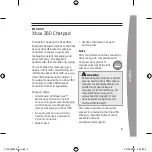
32
33
Rise of Flight - Iron Cross Edition
13.2 Takeoff
Take-off must be performed at full throttle. Otherwise the aircraft will gain speed
too slowly and you can stall and crash. In order to get maximum power from your
engine, it should be warmed up before takeoff for 2-3 minutes at 1000 rpm with
closed radiator shutters. Once warmed up and running smoothly, open the
radiator shutters completely and lean the fuel mixture by 10-20%. Give it full
throttle and head down the runway.
During a takeoff run an aircraft has the tendency to deviate sideways opposite to the
direction of the propeller spin. For instance, if a propeller rotates clockwise, an aircraft
will try to turn left. That’s why you should correct your course with the rudder. You
should twist the stick or push the pedals with rapid, but precise movements.
The smoothness of such movements will come with experience. And don’t forget
to return the rudder to a neutral position after the corrective movements because
the aircraft has inertia and will react to your control with some delay.
Otherwise, the aircraft could turn around or even perform a nose-over.
To begin the takeoff , you should lower the nose and raise the tail boom. This will
give you a better view forward and gain additional speed by picking up the tail
skid off the ground. To do this, push the joystick forward and lower the nose to
the horizon line. Maintain this position till the aircraft reaches its takeoff speed. Be
careful not to lower the nose too much otherwise the propeller could touch the
ground and damage itself.
After takeoff don`t try to rapidly gain altitude. Ensure that the aircraft has
accelerated enough by flying parallel to the ground for a little while then
gradually raising the nose to gain altitude.
13.3 Control and Maneuvering
Aircraft in general are designed to be stable in flight. This means that without
your intervention it will maintain flight for some time. During WWI this was not
always the case as the designs of the era were new and the art and science of
aircraft design was not as perfected as it is today. However, the essence of piloting
is the same which is to not interfere with the aircraft’s ability to fly, but to harness
its natural ability to provide lift and use it to an end. Your goal when flying these
aircraft is to control them gently and use their particular traits and features to give
you an advantage in combat. When trying to pilot an aircraft don`t overreact or
make sudden, harsh control inputs. You shouldn’t struggle with the aircraft. You
should help her to fly right and you should try to become “one” with the aircraft. If
you treat her right, she will help you in return.








































